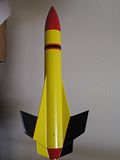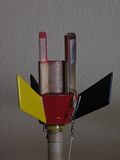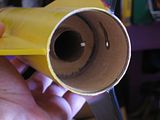JNUK
Well-Known Member
For the next season I am planning to build a two stage rack rocket. It will be my first rack design. To test some ides I did a little experiment that may be of some interest to someone here.
The aim was to establish the motor (B or C) exhaust envelop and to come up with a rack design that would not be damaged by the exhaust heat.
Here is the video.
[YOUTUBE]Uarya-8GGBE[/YOUTUBE]
Detailed description of the test and its results can be found in notes at the bottom of the page here.
The aim was to establish the motor (B or C) exhaust envelop and to come up with a rack design that would not be damaged by the exhaust heat.
Here is the video.
[YOUTUBE]Uarya-8GGBE[/YOUTUBE]
Detailed description of the test and its results can be found in notes at the bottom of the page here.
- In a two-stage design it is possible to avoid any exhaust heat damage to elements of the rack and fins by removing them from the heat-damage envelop (+- 8.5 degrees)
- Exhaust deposition envelop is +-30 degrees.
- It is not possible to avoid burn damage to racks longer than 60 mm. However damage from B6-4 motor is relatively minor thus the rack can be reused several times.
Last edited:













